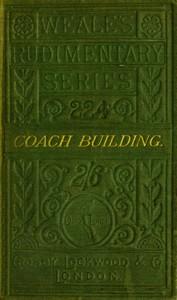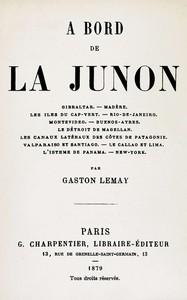Read this ebook for free! No credit card needed, absolutely nothing to pay.
Words: 63615 in 21 pages
This is an ebook sharing website. You can read the uploaded ebooks for free here. No credit cards needed, nothing to pay. If you want to own a digital copy of the ebook, or want to read offline with your favorite ebook-reader, then you can choose to buy and download the ebook.
A PRACTICAL TREATISE
ON
COACH-BUILDING.
GENERAL HISTORY.
The progress of the art of coach-making, like the progress of most inventions and discoveries, has been rather slow, we may say remarkably slow; sometimes it made a sudden start, but a reaction in the other direction generally settled it before much advance had been made; but seeing that the early portions of the Old Testament contain references to wheel carriages, it does seem rather strange that perfection should take so long to arrive at. This may be partly accounted for by the fact that the nations of the earth were always at war with one another, and consequently had no time to foster inventive power. And this has unfortunately been the case until comparatively recent times.
The first land carriages were doubtless very primitive contrivances. Though the "chariot" and the "waggon" are mentioned in Genesis, no description is given of their construction. Joseph rode in the second chariot of Pharaoh as a mark of great honour and dignity. "Waggons" were dispatched from the court of Egypt to convey thither the wives and little ones of the family of Jacob. From this, as well as the fact of the brethren of Joseph bearing their corn away on asses, we may infer that wheel carriages, even of the most simple construction, were not in general use at this time. It is very probable that the common vehicle of the period was an embryo sledge, drawn by man or beast along the ground.
The Bible and the hieroglyphics on the various ruins of ancient Egypt furnish us with the earliest authentic records. In the case of Egypt this is particularly valuable to us, because of the great degree of culture arrived at in the civilised arts. In fact it is the chief country of which we have any record of the progress of these arts, and though not actually established, it is extremely probable that to the Egyptians we owe the invention, or at least the introduction of the wheel. These people were early engaged in the erection of large buildings and monuments, of which the pyramids and sphinxes are such striking examples; and in order to convey the enormous blocks of stone and granite to their ultimate destination, the roller would be the first thing to suggest itself as a means of facilitating transit. The next step would be the formation of a truck, to which these rollers could be attached, and on which could be placed the materials to be moved. Progression with a contrivance of this kind would necessarily be rather slow, but it would soon become apparent that if a larger roller were used the motion could be accelerated. The next improvement would be an endeavour to lighten the rollers by sawing them into thick slices, and connecting them by a horizontal roller of smaller dimensions, giving a rude representation of a wheel and axle. The agricultural carts used by the peasantry of Chili, in South America, were made in this fashion until very recently. The further lightening of these cars would follow almost as a matter of course, by cutting the slices of the trunk to form the wheel, thinner, and further by cutting away portions of this slice, forming spokes. The wheel having arrived at this stage of perfection, the axle would call for a little attention. Up till the present, they would be fixed firmly to the wheels and revolve with them. This arrangement would cause great inconvenience in turning, for one wheel would revolve more rapidly than the other, by reason of the circle described by one wheel in turning round being greater than that of the other, and the vehicle would be liable to overturn. The next step was to arrange that the wheels could revolve independently of the axle. This being done, we have the wheel, in its principles, the same as at present.
The paintings and sculptures upon the walls of the temples and tombs of Egypt show that wheeled carriages were in use in that country at an early period . In the Bible they are usually translated "chariot." They are of great interest to us, as they formed the chief means of conveying man for 2,000 years before Christ, and were more or less the type of all the other vehicles of the ancient world. We find certain words used in describing them, both by Homer, who lived 1,000 years B.C., and by Moses, who lived at least 500 years earlier; and these words are the technical terms in use at the present day, such as axles, wheels, naves, tyres, spokes, &c. It is reasonable to infer from this, that the art to which these terms apply must have existed prior to the writers' description; so that any doubt as to the correctness of the Egyptian sculptures must be dispelled by the references of the above authors. In the fifth book of the Iliad "The awful Juno led out the golden-bitted horses, whilst Hebe fitted the whirling wheels on the iron axle of the swift chariot. The wheels had each eight brazen spokes, the felloes were of gold, secured with brazen tyres all round, admirable to the sight. The seat was of gold hung by silver cords, the beam or pole was of silver, at the end of which were hung the golden yoke and the golden reins."
The car was greatly used by the Romans, being adopted from the one used by the Etrurians , a neighbouring country on the Italian peninsula. These latter people were traditionally the first to place a hood or awning over the open two-wheeled car, and they showed great taste in decorating their vehicles in the manner familiar to us by the remains of their pottery. A very fine copy of one of the Roman cars is in the museum at South Kensington, cast from the original in the Vatican.
Herodotus mentions that the Scythians used a vehicle which consisted of a rough platform upon wheels, on which was placed a covering like a beehive, composed of basket work and covered with skins. When they pitched anywhere these huts were taken off, and served them as dwellings in lieu of tents. Fig. 4 shows one of their chariots.
The war chariots used by the Persians were much larger than those used by contemporary nations. The idea seems to have been to form a sort of turret on the car to protect the warriors in action. These vehicles were provided with curved blades, like scythes, which projected from the axletrees, for the purpose of maiming the enemy as they drove through them.
Sir William Gell, in his work on Pompeii, which was destroyed A.D. 79, mentions that three wheels had been dug out of the ruins in his day, very much like our modern wheels--a little dished, and 4 feet 3 inches high, with ten spokes rather thicker at each end than in the middle. He also gives an illustration of a cart used for the conveyance of wine in a large skin or leather bag; it is a four-wheeled cart, with an arch in the centre for the front wheel to turn under. The pole appears to end in a fork, and to be attached to the axle bed.
Free books android app tbrJar TBR JAR Read Free books online gutenberg
More posts by @FreeBooks










